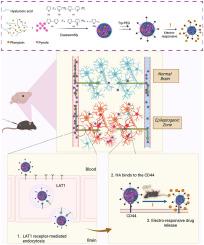用于抗癫痫药物的致痫区靶向纳米颗粒给药系统
IF 10.2
1区 医学
Q1 ENGINEERING, BIOMEDICAL
引用次数: 0
摘要
癫痫是一种慢性神经系统疾病,影响全世界6500多万人,其特征是神经元网络异常过度兴奋。传统的抗癫痫药物(asm),如苯妥英(PHT),由于血脑屏障(BBB)渗透性差和脱靶毒性,治疗效果有限。为了解决这些问题,本研究提出了一种以PHT为模型药物的电响应闭环系统给药系统(DDS)。该系统利用由聚吡咯(PPY)制成的电响应纳米颗粒,该纳米颗粒可以响应电刺激而收缩,从而在癫痫放电期间按需释放药物。此外,癫痫患者色氨酸代谢的过度激活导致色氨酸耗竭,促进其在癫痫发生区摄取,并产生“代谢诱捕”效应。同时,透明质酸(HA)与CD44受体结合,增强纳米颗粒在病变处的滞留,从而产生“靶向递送-延长滞留”效果。这种非侵入性靶向致痫区PPY-HA-PHT-Trp DDS可能会增强ASM效果,具有潜在的临床应用价值。本文章由计算机程序翻译,如有差异,请以英文原文为准。

Epileptogenic zone-targeting nanoparticle drug delivery system for antiseizure medication
Epilepsy is a chronic neurological disorder affecting over 65 million people worldwide, characterized by abnormal excessive excitation of neuronal networks. Traditional antiseizure medications (ASMs), such as phenytoin (PHT), have limited therapeutic efficacy due to poor blood-brain barrier (BBB) penetration and off-target toxicity. To address these issues, this study proposes an electrically responsive closed-loop system drug delivery system (DDS) using PHT as a model drug. The system utilizes electro-responsive nanoparticles made from polypyrrole (PPY), which can contract in response to electrical stimulation, allowing for on-demand drug release during epileptic discharges. Additionally, the excessive activation of tryptophan metabolism in people with epilepsy leads to tryptophan (Trp) depletion, promoting its uptake in the epileptogenic zone and creating a "metabolic trapping" effect. Meanwhile, hyaluronic acid (HA) binds to CD44 receptors, enhancing nanoparticle retention at the lesion, thereby creating a "targeted delivery-extended retention" effect. This non-invasive epileptogenic zone-targeting PPY-HA-PHT-Trp DDS may enhance ASM effect and have potential applications in clinical settings.
求助全文
通过发布文献求助,成功后即可免费获取论文全文。
去求助
来源期刊

Materials Today Bio
Multiple-
CiteScore
8.30
自引率
4.90%
发文量
303
审稿时长
30 days
期刊介绍:
Materials Today Bio is a multidisciplinary journal that specializes in the intersection between biology and materials science, chemistry, physics, engineering, and medicine. It covers various aspects such as the design and assembly of new structures, their interaction with biological systems, functionalization, bioimaging, therapies, and diagnostics in healthcare. The journal aims to showcase the most significant advancements and discoveries in this field. As part of the Materials Today family, Materials Today Bio provides rigorous peer review, quick decision-making, and high visibility for authors. It is indexed in Scopus, PubMed Central, Emerging Sources, Citation Index (ESCI), and Directory of Open Access Journals (DOAJ).
 求助内容:
求助内容: 应助结果提醒方式:
应助结果提醒方式:


